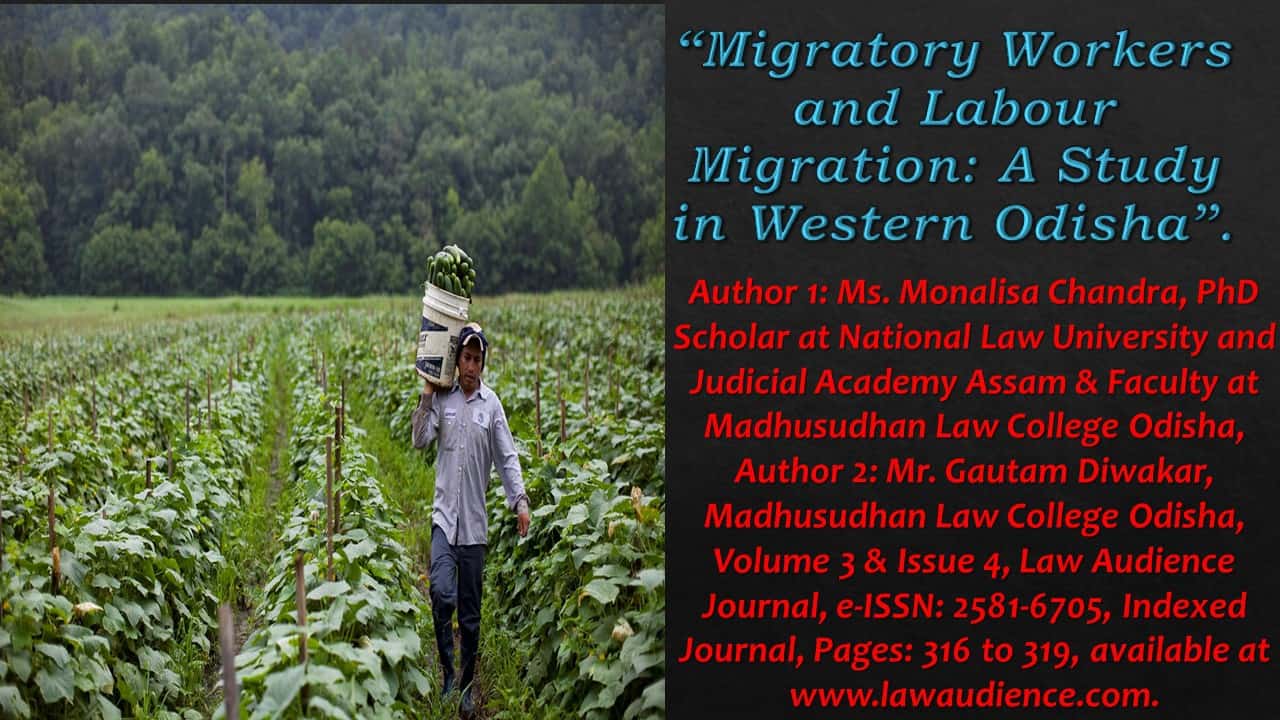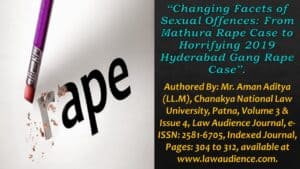Click here to download the full paper (PDF)
Author 1: Ms. Monalisa Chandra, PhD Scholar at National Law University and Judicial Academy Assam & Faculty at Madhusudhan Law College Odisha,
Author 2: Mr. Gautam Diwakar, Madhusudhan Law College Odisha,
Click here for Copyright Policy.
ABSTRACT:
“Labour migration must prove an irreversible feature of rural families’ lives in western Odisha. The nature, experience and ramifications of such migration to the most significant urban centres for construction work are examined in this paper. It also explains why authorities have now been required to safeguard fragile colloquial workers – the workforce, state and law departments – and how migrants depend on agents, middlemen and vendors who seem to be the most intimate operators to their wellbeing.
This survey of empirical work on the migrant labor from the Bolangir district of Western Odisha has different stages of defining. They are inner-state migrant labor or inter-state migrant labor. The definition determined for the seasonal labor migration and migrants’ workers may be as follows. The whole project was based on the Data Entry of the migratory worker those who have left their lands and houses to some inter-district or interstate migration owing to the need for employment and wages”.
The paper is presented with an observation of “Saintala and Deng” villages of Balangir. The observers on the ground level acquired the data on their own and collected them with the following.
Basic Details:
The basic Details include the name, address, total no of family members their educational and occupational details and the mandatory Aadhar Card number.
Property Status:
Then there is the property status declaration where the data of the ancestral land or government land or agricultural land is surveyed and is they any agricultural use of it or they own it as a household. What kind of irrigational method used, there are of two types of irrigation one is Watershed and canal irrigation .Details of other income sources also asked where the option of migratory labor was the most common.
Details of Migrant Laborers:
The details of migratory worker are taken from one of the family members who are the declaring, who describes that who in their family have migrated like if there are maximum males or females or children. Mostly Adolescent males are the majorities who have migrated in search of income source, then comes the number of females and few are the families who completely have shifted to new places like other districts and stated for livelihood. There are no children who have migrated as per the survey. Most of the Migrant workers are semi-skilled and unskilled, so work as contractual labors who work in Brick Kiln, or as Mechanic and general daily wage labor in construction sites if they were males. If they were female, they work mostly in the textile industry as tailors and garment are paid either as monthly/weekly wages paid in hand for their work. For most laborers, earnings are not sufficient, and range between Rs 10,000 and 15,000. Most migration takes place by the workers themselves; therefore, they travel as seasonal migrants in order to relocate to different states or districts within the state. They also go to other countries. However, there are other circumstances where contractors pay for the tasks and work in the workplace according to demand. Most of the cases, there is no governmental knowledge about such kind of labor migration. Most of the migratory worker who had migrated to the new locations provided with a place to stay or restroom, toilets and occasionally one-time food. But the condition was not up to the mark since there was no proper sanitation. To check their situation, either the police or the Legal Service Authority visited for the survey and asked if they had any idea about the governmental schemes like Ration card, MNREGA, Ujjwala Schemes etc. Most of them were not aware of such schemes.
Reasons for Migration:
The main cause of migration is there is livelihood or income source for a maximum of them. There has been no regular income source and were landless or had no agricultural land. There was no governmental support as per their information no work availability.
Family members of the Migrant:
Either parents of old age or children who formerly survived off the agricultural source of income were members of the migration workers’ family that were left behind. Most of them had access to all governmental schemes like Ration Card, MNREGA, Ujwala Scheme, etc.
II. OTHER IMPORTANT FACTORS:
II.I AGE DISTRIBUTION OF MIGRANTS – BALANGIR DISTRICT:
A particular stream of brick kilns developed in western Odisha and migrated in pursuit of jobs to the surrounding state of Andhra Pradesh, Telangana, Kerala and Gujarat. This movement is carried out both by men and women from the ST and OBC populations. In this system, about 11% of migrants are less than 14 years of age. The bulk of migrants, from the Balangir district of Western Odisha, fell between the ages of 18 and 25 years, indicating that this is the main period for young people to migrate. Around 92 per cent of migrants are under 46 years of age. Field findings indicate that, at this age, migrants prefer to withdraw and return to their villages.
II.II EDUCATION PROFILE OF MIGRANT WORKERS–BALANGIR DISTRICT OF WESTERN ODISHA:
Literacy lacks are a recurring concern for refugees, undermine their livelihood at their destination and frequently compel them to work in the smallest niche in the labour market in a more physical and unskilled way. The registration statistics for migrants indicate around 40% of immigrants are either analphabetic or can hardly sign their names in both areas. Only 7% were educated over 10th standard by all migrants. Of the 43,123 migrants registered, 826 were designated as and above qualified graduates. Around half of the migrants observed did not obtain primary and over 23% were analphabets. From this analysis, more than 50% of Western workers report higher secondary education (9th-12th days), compared with 26% in West Odisha, show the difference between the character of migrating labor in both areas.
II.III EMPLOYMENT TRENDS – IN WHICH SECTORS ARE MIGRANTS EMPLOYED?
In the lowest segments of the unorganized sector in your destination, the majority of migrant laborers are employed. These are areas that need a lot of manual labor, with little or no entrance obstacles, such as building, head loading, mining, agriculture and so on. In the Balangir district of Western Odisha the construction industry recruits the greatest number of immigrants (42%) and 52% respectively. A large proportion of refugees, over 80%, regard occupations as unskilled building labourers in the building sector. The West Odisha staff is 12% higher than the Coastal Odisha employees. Approximately 16% of migrants work as masons, although most work as artists, managers and Centre workers.
Unqualified builders earn an average monthly income of 5,272, while the qualified employees earn Rs. 6,980 monthly. In the coastal area all transportation, industries and the clothing sector are important sectors of labor. 4 percent of migrants from the area make up retail and hospitality. The hotel business and the producers distribute employees very evenly at various levels of skill. In textiles the rate of unqualified workers is 68% higher. Most of the workers, 72%, work as drivers in the coastal transport industry. Migrants employed in services are moving smaller. This includes plumbers, electricians, peons and local gardens. Balangir West Odisha District Migrant Worker Families.
While one group of employees is travelling to achieve one’s objectives, many others include people who leave their homes as well as family behind. Because in the village they have little or no payment resources. These individuals who live in remote communities also rely fully on the revenues of migrant labor and have no income in their own communities, even under great responsibility. Consequently, the problems of the family disputes are more complicated and encompass the range of vulnerabilities encountered by the family members in the community. This includes wives as well as children, furthermore often aged parents who mostly rely on the irregular allowances, discontinuous earnings from the agricultural labor or sometimes the contributions of neighbors for survival.
Cite this article as:
Ms. Monalisa Chandra & Mr. Gautam Diwakar, “Migratory Workers and Labour Migration: A Study in Western Odisha”, Vol.3 & Issue 4, Law Audience Journal (e-ISSN: 2581-6705), Pages 316 to 319 (24th April 2022), available at https://www.lawaudience.com/migratory-workers-and-labour-migration-a-study-in-western-odisha/.



